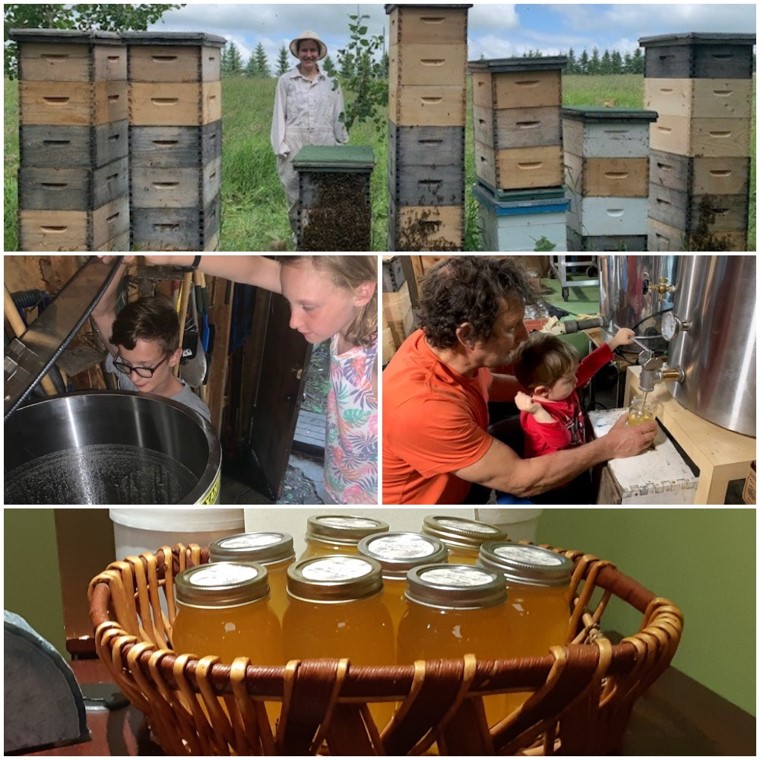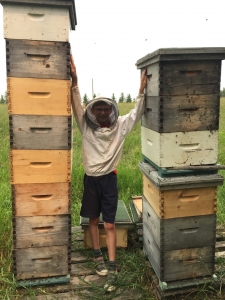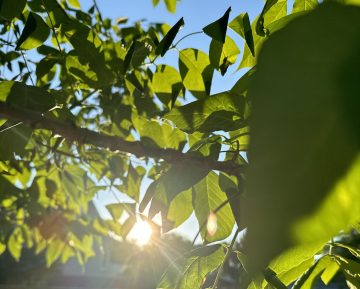Beekeeping is hot, heavy, and sticky… and yes, stingy. It is much more than the honey itself that keeps me coming back each year to the bees. Actually, I don’t eat as much honey as you may expect a beekeeper would – I mostly savour it in small amounts as a fine sweet flavour that can complement the taste of other foods. I am drawn to the less tangible rewards of working with them. I become immersed in the bee experience, sometimes completely engaged and focused, ritualistically observing and learning, and over time coming to sense their complexity beyond what I have learned from books. Whenever I am able to find the time to be with my bees, it never fails – when I return back to my city responsibilities I have regained a broader perspective of the world; my life problems seem smaller somehow, and have been rearranged into a more manageable perspective (all without me thinking about them!). A trip to the mountains or a good hike in the river valley can do that for me too; but the bees are special.
How did I get into bees? Well, I have a multifaceted relationship with bees. I was first introduced to bees as a young scientist in my 20’s working under a federal government assignment to develop diagnostic tests for various honey bee diseases; I got the bug indeed, and by my 30’s a weekend hobby had evolved into a commercial venture as a full time bee farmer with 1500 hives; in my 40’s, a rare honey crop of honeydew and my struggles with widespread areal pesticide crop spraying, led me to come back to the city and do a PhD in food quality analysis. There I innovated systems of residue analysis and learned about food and agriculture in new way. During that time, not only did I become an acupuncturist (note: I had wrecked my body beekeeping, and acupuncture helped me recover and run again!), but I continued to indulge this special relationship with bees as a hobbyist. My family tolerates this distraction from the normal life since they know how important it is to me… in fact, I recruit their help and support often in making this hobby work for me, since it is often very laborious and tedious in detail, and I couldn’t do it alone.

So here are a couple of facts you need to understand to realize how bees make their honey in the summer. The first pollen of the year comes from the pussy willows (which are the bees’ food to raise baby bees – it is the protein, fats, vitamins, micronutrients, etc). If the temperature gets to around 18 deg C or more, which it did a few days in early spring, the pussy willows can also supply the first nectar. Nectar is the sugar flowers use to entice bees to come and transfer their pollen from flower to flower for pollination. In the bees’ case, they forage for both pollen and honey, but not the same bee; usually each bee goes out on a dedicated errand mindset and specializes in either nectar or pollen collection. Nectar is just mostly just simple table sugar (sucrose which the bees then convert with a salivary enzyme called invertase into glucose and fructose) – this nectar and the honey they make from it are metabolized by bees to give them energy, so they can fly and do all the other tasks a busy bee must do.
But then the dandelions!!! When they bloom in late May, that is usually the first significant and critically timed sugar supply – and that can be the real key for the rest of the honey crop bees need to collect to be able to get through the winter (or beekeepers take from the bees!). The bees don’t really make extra honey to share with us from the dandelions (not that they ever want to share), since beekeepers generally only have extra from the summer flowers like clovers and canola in July/August. When a beehive does have extra in the spring or early summer, actually, that is their trigger to reproduce by splitting the hive and swarming, the old queen leaving with half of the bees (the youngest) and setting up house somewhere else, and a new queen taking over the old beehive. It has been this way for a long, long time before humans existed – but that is another story! Beekeepers do not like swarming since they not only loose half of their bees in the process but they loose most if not all the surplus honey they could make from that colony. They learn to manage bees so they prevent swarming and “split” the hives into two before the bees do it themselves (but that is another story).
The only time I ever extracted dandelion honey from all my hives due to a large spring surplus, was one special year back in 1994, and out of necessity I pulled more than 50lbs of dandelion honey off each hive to prevent the bees from swarming. That year we had an average crop of well over over 500 lbs per colony by the end of September (and there were some years with very little honey of course). But no, usually we let the bees keep their dandelion honey in the hive, since after the dandelions bloom in late May and June, there is really nothing else for the bees to forage on for nectar until the clovers and canola come in July. So for most of the month of June we call a spring nectar dearth.
For over 200 million years the honey bees have learned to deal with this supply and demand dearth problem; they calculate what to do in periods of anticipated shortage by limiting the number of bees and predicting what lies ahead in terms of food supply. So on one hand, in poor food supply, they will limit their population for “fear” of starving when they can’t feed everyone in the future. On the other hand, they cannot be too conservative. They must invest enough resources into making an adequate population that can make a minimal amount of honey when the rain does come, and the sun does shine, and the flowers do bloom! This way they will at least get through the winter without perishing as a colony during that much larger dearth period.
When we have a year like this year, when we had lots of moisture, fields full of dandelions (thanks farmers for not spraying these!), we were very lucky to have several days in May/June with hot weather at just the right time – bees could actually get out and forage on the dandelions that were just oozing out the nectar. Here the bees brought in enough extra provisions to have confidence going into the dearth period. Under this scenario, they really support the queen to lay lots more eggs, even through the dearth period – they created huge populations going into July, even though it was rainy. Some colonies likely had more than 50,000 bees.

One day I was out checking them out later in the afternoon, and they had stopped leaving the hive; thousands were all rushing to get home in time before a big thunderstorm hit, backing all up at the entrance like a people piling into a stadium for a big performance. They are smart and know when a storm will leave them abandoned in the field, and all the bees come home even before their honey stomachs are full when they sense the pressure drop. Some don’t make it back are likely to not return if the rain is harsh enough and long enough, since not even hiding out battered down by the rain under a leaf will protect a bee.
So I have one or two empty boxes on my beehives now waiting for later summer hot weather that may never come. I have learned that by mid-August, the bees make a decision to keep the effort going with maintaining a larger bee population or to wind things down. If the weather has shifted to cooler nights like it has now, the hive population and psychology shifts too, and even if warm days come, even the flowers don’t produce much, and the bees won’t bring in more honey either. We see it in the trees shifting already too.
Over the years I have learned to remember that despite all my plans and attempts to control things, that nature just has her way. I have learned to be prepared for the unexpected, and to watch carefully for signs of change, often very predictable change, and to go with the flow as it were.
The first very white honey we extracted this year has already set up a beautiful creamy texture, that only comes if you don’t over heat it when you are processing it and settling it and packing it. We then keep it in a cool place (ideally 15 deg C) until it is set solid. After that you can store it at room temperature and it stays in this wonderful creamy state for years. When the creamy honey melts in your mouth, it takes the heat from your mouth creates a wonderful cool sensation on the tongue (that is the food chemist in me knowing this).
So higher temperature heating or pasteurization of honey is not for food safety, but is done commercially to prevent its granulation and keep it liquid due to consumer preference. But eventually even pasteurized honey will granulate – but in this case it will often do so in a very coarse and unfavourable way. Due to the floral nature of Alberta honey, it tends to set up and crystalize quickly when it is not pasteurized, and this quick crystallization process affords it a uniquely creamy texture (slow crystallization equals big crystals that are sharp and not smooth to the tongue). Not pasteurizing honey also preserves the delicate enzymes that bees add to honey. An over-heated, enzyme-deactivated honey does not possess a capability to continue its normal maturation process (like a fine wine) and also loses it’s well known wound-healing capacity. A peroxidase enzyme is added by bees to help the nectar not ferment before it is ripened into honey, but coincidentally it is good for people and inhibits bacterial growth when applied with gauze on a burn for instance (Grandma new this, but now science has proven this too!).
So next time you put a teaspoon honey on bread, or in your tea, take a moment and recognize this food, which although is mostly just sugar, is much, much more than just a sweetener. It is a very special achievement by a group of insects working in spectacular collaboration, through many thousands of trips to individual flowers (each bee flies to between 100 and 1500 flowers to fill her 50 microlitre stomach), to collect the nectar (80% water), and then to evaporate off most of the nectar water weight away down to less than 1/4 the original volume (honey is only 16-18% moisture) all without heat, preserving the delicate and volatile floral aromas in the honey, just by fanning their wings to create a drying air current over little films of nectar drawn across their forked tongues, and by adding special enzymes, and then sealing it all with wax once the correct moisture is achieved, so it doesn’t ferment by taking on air moisture.

fly, honey bee, and bumble bee pollinators
Honey is a fine food indeed; yet remember bees do not care about us and do not make honey for us. Although many people are worried about honey bees in our modern era, as we should be, I think we should realize the worry is more directed not about bees per se, but about how we can continue to exploit sustainably them for our needs as pollinators of our foods in an inexpensive and effective way. That is likely in peril and is more than just a technological fix.
Bees have been around for hundreds as millions of years now, as long as there have been flowers that needed pollinating, they have evolved together. Bees will likely be around for millions of years to come, as long as there are flowers that need to be pollinated.





